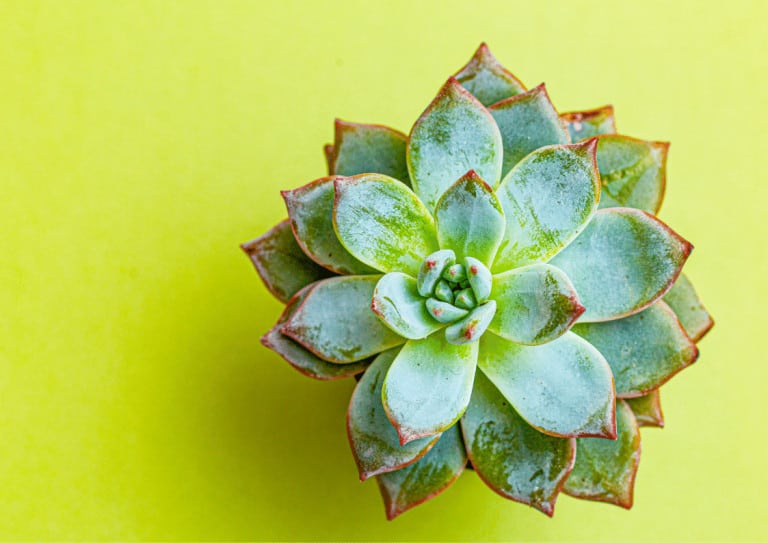The Secret To Cleaning Succulents With Farina
- Lakeisha Ethans
- February 26, 2022
If you buy something using the retail links in our articles, sometimes we earn a small affiliate commission. This does not impact the products we recommend.
Farina, also known as epicuticular wax, is a whitish bloom that coats the outer surface of cuticles and leaves on succulents. It creates a beautiful pastel appearance on certain species and serves numerous important purposes to the plant.
To clean succulents with farina without damaging the wax, you have to be extremely gentle. Using soft-bristled brushes and gentle blows of breath are the safest ways to get rid of dust that settles on your plants.
Farina’s main purpose is protection, with its functions including decreasing moisture loss, UV light effects, surface wetting, and insect infestation. While a plant can arguably survive without farina in a safe, indoor environment, it’s still much more beneficial to leave it intact.
Farina is surprisingly fragile and can be removed easily, so extra care has to be taken to avoid damaging the coating. In this article, we aim to help you prevent such damage.

How should I clean succulents with farina?
Farina can come off quite easily if you’re not careful, so you need to be gentle with a succulent to clean it without removing the wax. For the most part, succulents don’t need that much cleaning (unless they are sold covered in paint), so don’t try to clean yours more than strictly necessary.
As a matter of fact, farina itself can create a self-cleaning ability for a plant. This property is known as the lotus effect, occurring as farina forms little crystals along the surface of a plant. This means that the need to clean succulents is almost non-existent, especially since they’ll get a good wetting when you water them.
For most normal cleaning, simply use a soft brush to gently wipe away any dust on the top of your succulents. Be very delicate when you do this, just brushing enough to clear off light dust and nothing else. Items like clean feather dusters or makeup brushes can also be used, but make sure that they aren’t contaminated with other forms of dirt.
You can also use your breath to gently blow at any loose dust on a succulent, but that may not work well for more intensive cleaning needs, such as after repotting the plant. Regardless of your chosen method, remember that you shouldn’t use much force. Cloth and harder brushes are enough to accidentally remove farina if you’re being rough.
If your plant has pests on it, then you’ll need something more involved than a soft brush. For this, make a diluted rubbing alcohol solution and place it in a misting bottle. Spray or mist the solution over the affected leaves of your succulent. The solution shouldn’t harm farina, but Insects like mealybugs and whiteflies will be repelled or killed by it.
Finally, don’t make the mistake of trying to rub away dirt with your finger! Your skin has natural oils that can remove the farina coating and may even harm your plant’s leaves beneath the farina.
Do note that oil-based treatment and cleaning products, such as fungicides and pesticides, can easily remove farina. Check the contents of each product you intend to use before spraying and err on the side of caution.
Our Favorite Succulents And Supplies On Etsy
How can I differentiate farina from mildew?
Powdery mildew is a common problem for leaves that are over-watered or stay wet for too long. In some succulents, its appearance is quite similar to farina. It’s reasonable, then, that some plant owners may be concerned that their succulents are infected with mold.
The easiest way to differentiate between farina and powdery mildew is by odor. Mildew has a sour smell akin to must or mold while farina is completely odorless. Get down close to your succulent and smell the leaves. If you can’t smell anything, it’s likely just farina.
Another way to determine farina from mildew is through evenness. Farina is a wax coating that is meant to spread evenly throughout succulents to protect them. Mildew appears in splotches and is not even. Patchiness in the powdery appearance points to mildew. Mildew also usually covers only a couple of leaves, not all of a plant’s leaves.
Finally, mildew will make your succulents sick. It’s a result of fungal spores, so it begins to damage leaves and deform their shape and appearance. If you notice that happening to your succulent, then you’ve had mildew on your plant for a while. You’ll have to act quickly to save your succulent!
What happens if farina is removed and does it grow back?
You already know the details of farina. They give succulents their lovely soft, muted colors and protect them from pathogens, insects, harsh UV rays, and weather conditions. They also prevent the plant from absorbing and losing excessive amounts of water, as farina is hydrophobic and repels liquid.
As such, it’s easy to understand what might happen when you remove farina from a succulent. The epicuticular wax’s removal may put a succulent at risk of insect infestation, fungal infection, and burns from sun exposure. The plant may also lose too much water on hot days or might absorb too much when watered.
With that being said, farina removal does not necessarily mean that your succulent is doomed. They can in fact survive far worse.
It does, however, mean that you’ll have to take extra care of that particular plant from now on. Protect the plant from the sunlight as it gets used to life without its layer of protection and be a little more mindful of how you handle it.
Once removed, it’s highly unlikely that farina will ever grow back. Some species can regrow a very thin farina layer, but this won’t replace the full glory of its original condition.
The good news is that new portions of a succulent will have their farina layer. Eventually, as new parts of the plant replace the old, you’ll have a fully coated succulent again. It’ll just take a little while and will require your added attention to get there.
Take home message
Succulents need their farina for protection against moisture, UV rays, pests, and other damage. You can clean succulents with gentle means, such as soft brushes, blowing away dust, or misting with alcohol solutions.
While they can survive without the wax coating, it’s really best to leave farina intact on succulents. The wax can’t grow back, so if you decide to remove it, make sure you’re committed to the extra care your plant will need!

Lakeisha Ethans
Houseplant Writer
Mother to two humans and hundreds of plant babies. Lakeisha uses her 15 years of experience as a content writer to specialise in simplifying what you need to know to grow and care for all indoor plants.
Similar Posts
Why Are My Monstera Aerial Roots Shriveling?
Should you be worried if the aerial roots on your Monstera starts shriveling up? Does this happen naturally or is it a sign of a poorly plant?
Sinus Suffering: Could Your Houseplants Be the Culprit?
Fruit flies can be hard to catch, as their small size makes them elusive to many common insect predators. What carnivorous plants can get the job done?



